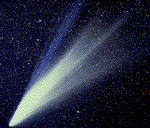Comets

Comet Facts
- Unlike the other small bodies in the solar system, comets have been known
since antiquity. There are Chinese records of
Comet Halley going
back to at least 240 BC. The famous Bayeux Tapestry, which
commemorates the Norman Conquest of England in 1066, depicts an apparition of
Comet Halley.
- As of 1995, 878 comets have been cataloged and their orbits at least roughly
calculated. Of these 184 are periodic comets (orbital periods
less than 200 years); some of the remainder are no doubt periodic as well, but
their orbits have not been determined with sufficient accuracy to tell for sure.
- Comets are sometimes called dirty snowballs or "icy mudballs". They
are a mixture of ices (both water and frozen gases) and dust that
for some reason didn't get incorporated into planets when the solar system
was formed. This makes them very interesting as samples of the early
history of the solar system.
- When they are near the Sun and active,
comets have several distinct parts:
- nucleus: relatively solid and stable, mostly ice and gas with a
small amount of dust and other solids;
- coma: dense cloud of water, carbon dioxide and other neutral
gases sublimed off of the nucleus;
- hydrogen cloud: huge (millions of km in diameter)
but very sparse envelope of neutral hydrogen;
- dust tail: up to 10 million km long composed of smoke-sized dust
particles driven off the nucleus by escaping gases; this is the most
prominent part of a comet to the naked eye;
- ion tail: up to 100 million
km long composed of plasma and laced with
rays and streamers caused by interactions with the
solar wind.
- Comets are invisible except when they are near the Sun.
Most comets have highly eccentric
orbits which take them far beyond the orbit of Pluto;
these are seen once and then disappear for millennia.
Only the short- and intermediate-period comets
(like Comet Halley), stay within the orbit of Pluto for a
significant fraction of their orbits.
- After 500 or so passes near the Sun off most of a comet's ice and gas
is lost leaving
a rocky object very much like an asteroid
in appearance.
(Perhaps half of the near-Earth asteroids may be "dead" comets.)
A comet whose orbit takes it near the Sun is also likely to
either impact one of the planets or the Sun
or to be ejected out of the solar system by a
close encounter (esp. with Jupiter).
- By far the most famous comet is Comet Halley
but SL 9 was a "big hit" for a week
in the summer of 1994.
- Meteor shower sometimes occur when the Earth passes thru the orbit of a comet.
Some occur with great regularity: the Perseid meteor shower occurs
every year between August 9 and 13 when the Earth passes thru the orbit of
Comet Swift-Tuttle. Comet Halley is the source of the Orionid
shower in October.
- Many comets are first discovered by amateur astronomers.
Pictures
- (above) Comet Kohoutek 227k gif
 Comet West showing distinct dust and ion tails
111k gif
Comet West showing distinct dust and ion tails
111k gif
 Comet West
63k gif
Comet West
63k gif
 Comet Hyakutake (Fred Burger)
68k jpg;
209k gif
Comet Hyakutake (Fred Burger)
68k jpg;
209k gif
 Comet Hyakutake nucleus (HST)
11k jpg;
67k gif
Comet Hyakutake nucleus (HST)
11k jpg;
67k gif
 Comet Hale-Bopp (HST)
html
Comet Hale-Bopp (HST)
html
- ... more comet images
More about comets
Open Issues
- What happens to comets after they have lost their volatile materials?
- What mechanism(s) perturb comets from their origin in the Oort cloud into
orbits that take them into the inner solar system?
- Was it a comet or something else that caused the Tunguska fireball over
central Siberia in 1908?
- Was it a comet or an asteroid that caused the Chicxulub crater in the
Yucatan (and probably caused the extinction of the dinosaurs)?
- The Stardust mission will return samples
a comet for study in earthly labs.
 ... Sun
... Small Bodies
... Comets
... Halley
...
... Sun
... Small Bodies
... Comets
... Halley
... 

Bill Arnett; last updated:
1996 April 28
 Comet West showing distinct dust and ion tails
111k gif
Comet West showing distinct dust and ion tails
111k gif
 Comet West
63k gif
Comet West
63k gif
 Comet Hyakutake (Fred Burger)
68k jpg;
209k gif
Comet Hyakutake (Fred Burger)
68k jpg;
209k gif
 Comet Hyakutake nucleus (HST)
11k jpg;
67k gif
Comet Hyakutake nucleus (HST)
11k jpg;
67k gif
 Comet Hale-Bopp (HST)
html
Comet Hale-Bopp (HST)
html

 ... Sun
... Small Bodies
... Comets
... Halley
...
... Sun
... Small Bodies
... Comets
... Halley
... 
